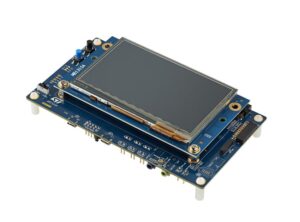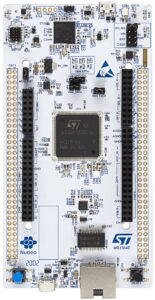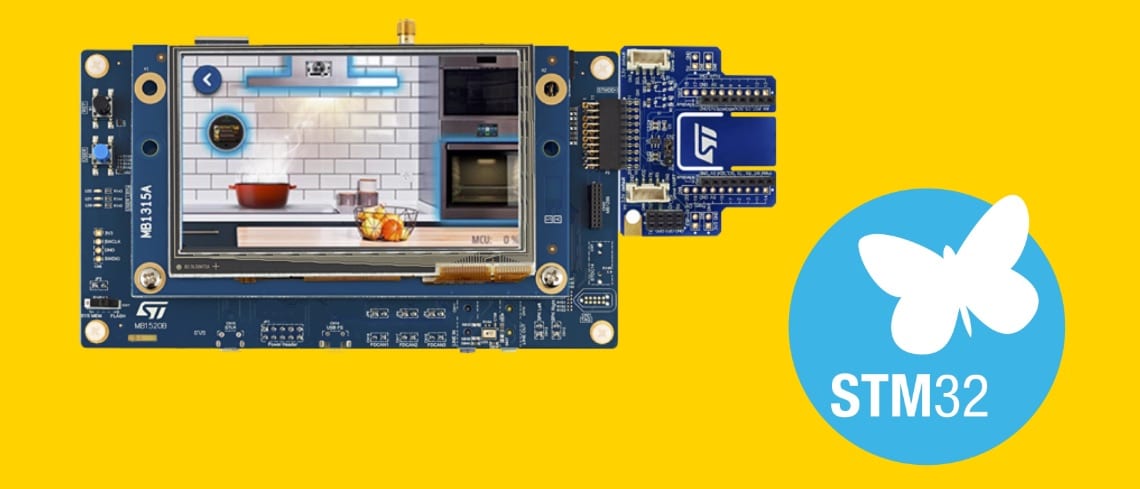STM32H723 and more: To improve the accessibility of our content, please find the audio version of this blog post.
We are launching today the STM32H723, STM32H733, STM32H725, STM32H735, and STM32H730. They are the first STM32H7s running at 550 MHz. They are also the first STM32H7s with a 12-bit analog-to-digital converter sampling at five megasamples per second. And they are the first with 64 KB of L1 cache (32 KB for data and instructions respectively). Nevertheless, despite the significant performance bump, the package remains small. The new models can reach 2778 points in CoreMark and offer 1177 DMIPS. However, with up to 1 MB of Flash and 564 KB of RAM, their memory configuration sits at the middle of the portfolio. The reason is that the new STM32H7s target industrial automation that demands more performance in a contained footprint.Could It Run Doom?
As we expected, the rise of graphical user interfaces marks the start of this new decade. Industrial applications are increasingly relying on larger displays. Moreover, the graphical assets are richer, animations smoother, and layouts more complex. Hence, engineers face a new challenge because they must do more with the same size and financial constraints. BOM costs mustn’t skyrocket, and PCBs ought to have a similar design. Adding a ton of memory is thus out of the question. Hence, in the face of this struggle, our engineers took an unorthodox approach. Traditionally, manufacturers indiscriminately boost all specifications and hope for the best. The STM32H723, STM32H733, STM32H725, STM32H735, and STM32H730 adopt a different strategy. Our teams tailored their architecture to meet the specific needs of recent industrial applications.
2 Demo Boards: STM32H735G-DK and NUCLEO-H723ZG
Showcasing the benefits of the new devices can potentially be a struggle. Hence, the best way to convince managers that the new MCUs enable new applications is with a development board. We are, therefore, releasing the STM32H735G-DK, which allows engineers to simulate any of the devices launching today. Indeed, the STM32H7x5 and STM32H730A/I house an LDO and an SMPS while the STM32H7x3 and STM32H730V/Z only have the former. Additionally, the STM32H73x comes with a cryptocore, unlike the STM32H72x. The STM32H735G-DK thus houses everything teams need to test all the new STM32H7s presented today. Nevertheless, we are also releasing the NUCLEO-H723ZG. Teams that wish to build a proof-of-concept around the STM32H723 rapidly will gravitate toward it.
Now that engineers have a platform for their demo, their next step is to determine what to show to their hierarchy. We will thus list three potential applications that help explain the architecture that drives our new devices. We will look at richer UIs, predictive maintenance, and security.
STM32H723, STM32H733, STM32H725, STM32H735, and STM32H730: How to Showcase Meaningful Performance
Richer GUIs Without External Memory

Let’s take a traditional 2.2-inch display with a resolution of 320 x 240 (QVGA). It’s, after all, a typical screen in many industrial applications. Assuming a color depth of 24 bits per pixel, we can estimate the framebuffer at 1,843,200 bits or 230 kB approximately. Hence, we see that the memory configuration of the STM32H723, STM32H733, STM32H725, STM32H735, and STM32H730 can quickly drive such display without needing additional RAM. Engineers may also choose to lower the color depth to drive larger displays. For instance, using 8 bits per pixel can mean using a 4.3-inch screen. Additionally, thanks to the frequency boost, the new devices can offer better animations and smoother transitions. The new MCUs can thus better showcase what teams create in TouchGFX Designer, for instance, while keeping the Bill of Materials in check.
Richer GUIs With External Memory

Other engineers may still wish to use external RAM, in which case, they now have two new possibilities. They can use the STM32H730. As a member of the Value Line series, it only embarks 128 KB of Flash, thus keeping the price even lower. Or developers can use today’s STM32H72x or the other STM32H73x to keep some code inside the MCU for performance or security purposes. For instance, engineers wishing to drive a 7-inch display will most likely use external RAM regardless. However, they may choose an STM32H723, STM32H733, STM32H725, or STM32H735 to keep part of the graphical framework in the embedded Flash to ensure a better framerate. One may also use the internal memory to benefit from features like Secure Firmware Install or Secure Module Install.
The new devices sit between the STM32H7A3/B3 and the STM32H745/755. The former has more memory, but it runs at far slower speeds and focuses more on lower power consumption. It targets applications that put the onus on their graphical interfaces, but don’t need significant computational throughput. On the other hand, the STM32H745/755 has more memory and a dual-core architecture to prioritize performances. The STM32H723, STM32H733, STM32H725, STM32H735, and STM32H730 offer a different compromise. They have the best single-threaded performance of all STM32H7s, but their RAM and Flash can keep BOMs down.
STM32H723, STM32H733, STM32H725, STM32H735, and STM32H730: How to Experience Significant Optimizations
More Accurate Predictive Maintenance Thanks to a Faster ADC
Effective factory and home automation require that applications process a lot of data. For instance, one may use vibration monitoring to rely on predictive maintenance. However, unless the number of data points from the sensor is large enough, the system can’t draw proper conclusions. Hence, to solve this issue, the STM32H723, STM32H733, STM32H725, STM32H735, and STM32H730 have a 12-bit ADC. Capable of five megasamples per second, it can guarantee rapid controls or fast Fourier transforms, among other things. In addition, the fast 16-Bit ADC usually found on other STM32H7s is still present on these new devices. Moreover, thanks to its junction temperature of 140 ºC and surface temperature of 125 ºC, ST can guarantee such level of performance under the harshest conditions. Similarly, the new devices have error code correction mechanisms on all Flash and RAM to offer a more robust architecture.
On-the-Fly Decryption for a More Thorough Security
Security is another critical aspect of industrial application, but the need for external memory can complicate things. Embedded memory is far less accessible. It is thus a lot less vulnerable to a data dump, for example. Hence, it is imperative to help developers secure their data or code stored on an external Flash. As a result, the STM32H733, the STM32H735, and the STM32H730 (those with crypto-core) support on-the-fly decryption (OTFDec). Previously, the STM32H7A and STM32H7B were the only ones to offer it. With this new crop of MCUs, engineers can offer more security without a performance penalty. Additionally, the new devices integrate two OctoSPI interfaces to connect to both an external Flash and an external RAM.
Next Steps
Career Boosters
- Attend the ST webinar on the STM32H723, STM32H733, STM32H725, STM32H735, and STM32H730
- Check out the iAR webinar on the STM32H72x/3x (for Europe, for Americas)
Learn more about the STM32H7 series
- STM32H7, the Most Powerful Cortex-M7 MCU, Breaks the 2000-point Threshold in CoreMark
- STM32H7: First Dual Core Version, More Accessible Single Core Models
- STM32F7 and H7 Value Line: Flash Trimmed, Possibilities Flourish
- STM32H7A3, STM32H7B3, and STM32H7B0: 1.4 MB of RAM, Better Security, Greater Efficiency
- First STM32H7 Dual Core / Value Line: 2 Videos to Get Started
- Everything STM32H7 related
